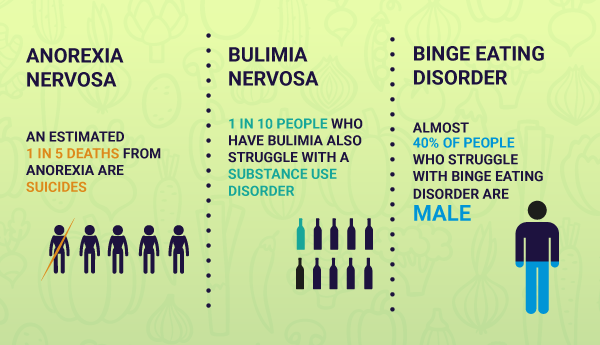Facts About Eating Disorder Recovery Uncovered
Wiki Article
Not known Facts About Eating Disorder Recovery
Table of ContentsAbout Eating Disorder RecoveryThe Of Eating Disorder RecoveryAll about Eating Disorder RecoveryThe 2-Minute Rule for Eating Disorder RecoveryLittle Known Facts About Eating Disorder Recovery.

ARFID is frequently considered a severe type of picky consuming. Some children are picky eaters and might be diagnosed with ARFID due to the fact that they don't eat sufficient calories to create and expand. Adults can be detected with ARFID as well, as well as along with not establishing physically, they may have difficulty with maintaining basic physical functions.
Rumination disorder is an eating condition that includes frequently spewing food. Someone with rumination disorder doesn't appear to do this purposefully.
How Eating Disorder Recovery can Save You Time, Stress, and Money.
Individuals who are identified with rumination eating condition are regularly instructed to replace the regurgitation with deep breathing techniques. Orthorexia is a fairly brand-new term that has not yet been widely accepted. Orthorexia nervosa is not yet a recognized consuming condition medical diagnosis. This does not suggest that orthorexia is not hazardous.Orthorexia is specified as a fascination with eating healthy and balanced food as well as staying clear of unhealthy food. An individual with orthorexia is likely to experience some problems in their life due to their obsession with healthy and balanced eating.
Like orthorexia, diabulimia is not yet an officially acknowledged eating disorder. Diabulimia is a severe and potentially life-threatening condition. Recognizing precisely what diabulimia is can aid recognize people that are fighting with this condition and also may likewise go to risk of creating other eating problems. Diabulimia refers to the calculated manipulation of insulin degrees by a person with type 1 diabetes mellitus to set off severe weight management.
Some Ideas on Eating Disorder Recovery You Need To Know
Other Specified Feeding or Eating Condition, much more generally described as OSFED, was formerly referred to as Consuming Disorder Not Or Else Defined (EDNOS). An OSFED eating problem may not meet the analysis criteria for other eating conditions but is nevertheless serious as well as possibly serious. OSFED refers to a condition that has the basic features of anorexia or bulimia however does not fulfill the full analysis requirements for either of these problems.An individual with an OSFED is just as most likely to have severe clinical repercussions as people who totally fit an eating disorder diagnosis. Someone that has an OSFED might be just as likely to die as a result of disordered eating as any person else with an eating condition. Eating conditions may be triggered by co-occurring psychological health and wellness problems and also can create physical conditions that can be life-threatening.
Acknowledging the very early indication of consuming problems can make an incredible distinction in the long-term wellness results brought on by the problem. Symptoms and signs of consuming conditions can be normally divided right into 2 sub-categories: behavior (as well as emotional) indications and also physical indicators. Common psychological as anchor well as behavior signs of an eating disorder might not constantly be conveniently identifiable.
Eating Disorder Recovery Things To Know Before You Get This

In scenarios where common behavioral and also emotional signs and symptoms are incapable to be check that observed, a medical professional might identify an eating disorder exclusively based upon physical indications (eating disorder recovery). Some typical physical signs and symptoms of an eating disorder consist of: Visible changes in weight (both gains as well as losses)Belly cramps, Irregular bowel movements, Acid reflux, Menstruation irregularities, including loss of periods or missed out on durations, Difficulty focusing or enduring focus, Wooziness or fainting, particularly after standing, Sleeping problems, Cuts and also calluses on fingers, Oral problems Get More Information like enamel erosion, tooth cavities and tooth level of sensitivity, Dry skin, hair and nails Like various other psychological health and wellness problems, consuming problems are triggered by a mix of environmental, genetic and also social variables.
For instance, a dysfunctional hormone reaction to stress may recommend a sensitivity to establishing an eating condition. Social situations connected with sporting activities, modeling or other professions focusing on body picture as well as weight control might influence the development of eating disorders. The National Alliance on Mental Disease records that people are far extra most likely to create an eating disorder if among their instant relative has one.
Not known Factual Statements About Eating Disorder Recovery
Indication differ from individual to individual, however some variables are most likely to affect an individual's risk of creating an eating problem (eating disorder recovery). Some biological risk variables that are suitable to individuals with anorexia, bulimia nervosa or binge eating disorder include: Having a family members participant with an eating disorder, Having a member of the family with one more mental health condition Perfectionism, Body picture dissatisfaction, Background of an anxiety conditionInflexible thinking Weight stigma, Background of diet programs, Being teased or harassed, Limited socials media, History of injury Similar to other psychological wellness conditions, consuming problems and dependencies often co-occur.In addition, up to 35 percent of people with compound use conditions additionally had an eating problem. The most typical substances abused by individuals with an eating problem consist of: Alcohol, Laxatives, Emetics, Diuretics, Amphetamines, Heroin, Drug A lot of these compounds are known for their appetite-suppressing negative effects. Twin diagnosis of consuming disorders as well as drug abuse requires comprehensive therapy for both problems.
Report this wiki page